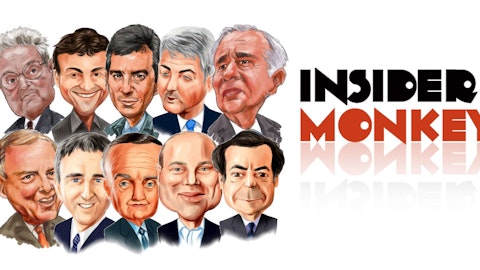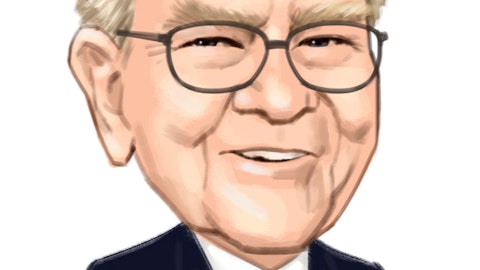A whopping number of Form 13Fs filed with the U.S. Securities and Exchange Commission have been processed by Insider Monkey, so that individual investors can look at the overall hedge fund sentiment towards the stocks included in their watchlists. These freshly-submitted public filings disclose money managers’ equity positions as of the end of the three-month period that ended December 31, so let’s proceed with the discussion of the hedge fund sentiment on Microsoft Corporation (NASDAQ:MSFT).
At Insider Monkey, we track more than 800 hedge funds (about 786 of which filed Form 13Fs this quarter) and measure the performance of their long stock picks in real time. Data from eVestment shows that concerned investors have been pulling some of their capital from hedge funds recently, dropping their collective assets under management to under $3 trillion for the first time since May 2014. Part of this is due to the media piling ruthlessly on hedge funds over the past year and “celebrating” the large losses of hedge fund titans like Bill Ackman. However, while 2015 was undoubtedly a difficult one for the industry, our data shows that hedge funds’ stock picks are outperforming the market so far in 2016, topping the S&P 500 Total Return Index by 50 basis points and the Russell 2000 Index by 410 basis points during the first two months of this year. So on average, it is a good idea to pay attention to what hedge funds are doing. Keeping this in mind, let’s take a look at the hedge fund activity in Microsoft during the fourth quarter.
Microsoft Corporation (NASDAQ:MSFT) has seen an increase in support from the world’s most elite money managers recently. MSFT was in 140 hedge funds’ portfolios at the end of the fourth quarter of 2015. There were 113 hedge funds in our database with MSFT holdings at the end of the previous quarter. The level and the change in hedge fund popularity aren’t the only variables you need to analyze to decipher hedge funds’ perspectives. Let’s see what some of the top money managers have to say about the tech giant, beginning with Barry Rosenstein, who had this to say about Microsoft in his third quarter letter to investors:
Follow Microsoft Corp (NASDAQ:MSFT)
Follow Microsoft Corp (NASDAQ:MSFT)
“We have been following Microsoft for the last two years, watching with interest the changes taking place in the boardroom and in the executive ranks. In August when MSFT sold off with the pullback in the market, we established a new long position. On our numbers, we acquired our position at about 11x 2016 FCF per share (ex-cash) which we believe provides solid downside valuation protection for a growing franchise of MSFT’s quality. We see multiple avenues for MSFT to increase earnings and free cash flow per share over the next twelve to twenty four months. First, taking a look at margins, we observe that MSFT’s operating margins were at 39% as recently as four years ago but ended FY 2015 at 30.0%. In dollar terms, MSFT spends $32 billion on operating expenses, $10 billion more than Apple, Inc. (AAPL) with less than half the sales of Apple, more than Alphabet, Inc (GOOGL), which is famously profligate, and more than Oracle Corp. (ORCL), Intel Corp (INTC) and International Business Machines Corp. (IBM). We think there is plenty of room to drive profitability and believe that management can continue to beat on the opex line, as they have now for seven of the last eight quarters. Second, MSFT has a strong capital return program in place. We expect dividends to continue to increase and for about $4 billion of cash to be directed toward share repurchases on a quarterly basis. MSFT is rated AAA, a rating it deserves but does not need, and the capital return program we forecast would still leave the company in a net cash position. If the finance department in Redmond ever decided to really pull hard on the capital return lever, substantially more cash could be returned to shareholders without in any way imperiling the business. Third, MSFT is undergoing a business model transformation that we believe is advantageous for customers and for owners. The transition of office from a license selling model to an annual subscription service will double the lifetime value or a license customer and has the potential to improve the user experience as updates are continuously provided in a cloud service model. Speaking of the cloud, we believe that the relevant scale enterprise cloud players have narrowed to two leaders – AWS and Azure. In the most recent quarter, the Azure business more than doubled year over year. Last, and this is a softer point and therefore harder to quantify, we are impressed by Satya Nadella and the management and product decisions he is making to improve the culture and the image of Microsoft. Putting it all together, we see an asymmetric risk/reward profile in a large cap leader undergoing a significant transformation. This is precisely the type of value + catalyst situation we are looking to put capital behind in today’s environment.”
Jeffrey Ubben‘s ValueAct Capital, which sold 18.65 million Microsoft shares in the fourth quarter for portfolio management purposes, had this to say about Microsoft (and Adobe Systems Incorporated (NASDAQ:ADBE)) in a letter to investors on February 4:





